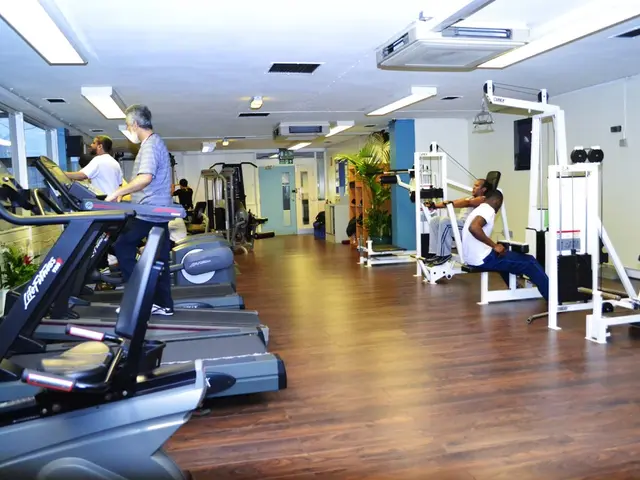Improved Sexual Function through Yoga Practice: Discover the Advantages
Sure, here's a revised version of the article:
Yoga has gained popularity for improving various aspects of health, including the often-elusive domain of sexual well-being. But does the science back up the claims? Here's a deep dive into the research.
From depression and anxiety to metabolic syndrome and diabetes, yoga has been scientifically proven to provide a plethora of health benefits. More recent studies even reveal that yoga can modulate inflammation, reduce stress, and boost the production of a protein essential for keeping the brain young and healthy.
But the question remains: can yoga also enhance our sex lives?
Empowering Women's Sexual Function
One of the frequently cited studies on this topic was published in The Journal of Sexual Medicine and explored the effects of 12 weeks of yoga on 40 women over the age of 45. research correlation Women who participated reported significant improvements in their sexual function across various categories, including desire, arousal, lubrication, orgasm, satisfaction, and pain. In fact, an impressive 75 percent of the women reported an improvement in their sex life after completing the yoga training. The training focused on 22 yogasanas, or poses, known to improve core strength, digestion, pelvic floor strength, and mood.
Elevating Men's Sexual Satisfaction
It's not just women who stand to benefit from yoga. A study led by esteemed neurologist Dr. Vikas Dhikav, based at the Dr. Ram Manohar Lohia Hospital in New Delhi, India, investigated the effects of a 12-week yoga program on male sexual satisfaction. The results indicated remarkable improvements in male sexual satisfaction across all aspects, including desire, intercourse satisfaction, performance, confidence, partner synchronization, erection, ejaculatory control, and orgasm.
If that's not enough, another study by the same team found that yoga is a viable, nonpharmacological alternative to fluoxetine (Prozac) for addressing premature ejaculation.
Yoga's Sex-Enhancing Mechanisms
Yoga's impact on sexual function may be due to several factors. A review of the literature spearheaded by researchers at the University of British Columbia helps us understand some of these mechanisms.
The review, led by professor Lori Brotto, explains that yoga regulates attention, breathing, and stress levels, and activates the part of the nervous system responsible for relaxation. All of these effects are believed to be associated with improved sexual response.
Furthermore, female practitioners of yoga tend to be less likely to objectify their bodies, and more aware of their physical selves, which could lead to increased sexual responsibility, assertiveness, and desire.

The Power of Moola Bandha
While the idea of releasing blocked energy in root chakras and moving kundalini energy up and down the spine may lack scientific backing, other yogic concepts, like Moola Bandha, could be more persuasive to skeptics.
Moola Bandha is a contraction of the perineal muscles that stimulates the pelvic region's sensory-motor and autonomic nervous systems. This contraction enforces parasympathetic activity in the body, potentially leading to improved sexual health benefits in women, such as relieving period pain, easing childbirth pain, and addressing sexual difficulties.
Moola Bandha shares similarities with the modern, medically recommended Kegel exercises, which are thought to prevent urinary incontinence and help both men and women enjoy sex for longer.
Another yoga pose, Bhekasana (the Frog Pose), is known to strengthen the pelvic floor muscles and might help relieve symptoms of vestibulodynia and vaginismus in women.
The State of the Evidence
Though the potential sexual benefits of yoga are tempting, it's essential to keep in mind the significant discrepancy between the amount of empirical (experimental) evidence and the abundance of anecdotal evidence available online.
However, despite the limited number of well-designed studies, the evidence supporting yoga's benefits for sexual function continues to grow, particularly for women with specific conditions like metabolic syndrome or MS.
A randomized controlled trial, for example, found that a 12-week yoga program led to significant improvements in arousal and lubrication in women with metabolic syndrome, whereas no such improvements were observed in the control group.
A randomized controlled study looking at the sexual benefits of yoga for women living with multiple sclerosis also revealed positive results. The participants who undertook a 3-month yoga training program showed improvements in physical ability and sexual function, while women in the control group experienced worsening symptoms.
In summary, while more research is needed to fully understand yoga's impact on sexual well-being, the existing data provides compelling reasons to explore the joys and benefits of incorporating yoga into our daily routines.
- Yoga, as discovered in a study published in The Journal of Sexual Medicine, has been shown to significantly improve sexual function in women aged 45 and above, particularly in categories like desire, arousal, lubrication, orgasm, satisfaction, and pain.
- Not only women, but men can also benefit from yoga, as indicated by a study led by Dr. Vikas Dhikav, showing improvements in male sexual satisfaction across all aspects including desire, intercourse satisfaction, performance, confidence, partner synchronization, erection, ejaculatory control, and orgasm.
- A review of literature led by professor Lori Brotto from the University of British Columbia suggests that the mechanisms behind yoga's sexual function enhancement may be due to its regulation of attention, breathing, stress levels, and activation of the nervous system responsible for relaxation, which are believed to be associated with improved sexual response.
- While some yogic concepts like moving kundalini energy may lack scientific backing, others, such as Moola Bandha and Bhekasana (the Frog Pose), offer potential benefits for sexual health, including addressing sexual difficulties in women, preventing urinary incontinence, and possibly relieving symptoms of vestibulodynia and vaginismus.








